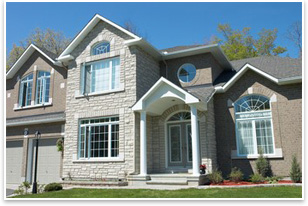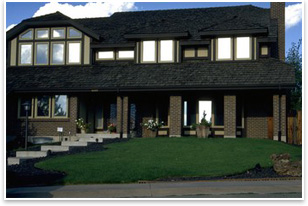SUSTAINABILITY
Does Size Really Matter?
by Michael J. Crosbie, PhD, AIA
 How do you . . . compare a house’s size with its carbon dioxide emissions? How do you . . . compare a house’s size with its carbon dioxide emissions?
Summary: When U.S. Congressman John Dingell (D-Mich.) in August suggested as part of a proposed “carbon tax” bill to punish owners of homes larger than 3,000 square feet, he certainly got the attention of homebuilders. Dingell, who chairs the House Committee on Energy and Commerce, said he would introduce legislation that would include, among other measures, a $100 per ton tax on carbon emissions, a 50-cent gasoline tax, and a “cap-and-trade” emissions program that would allow industries to trade pollution credits with low-polluting companies. The goal of the proposed legislation is to reduce carbon emissions by 60-80 percent by the year 2050.
Taxing McMansions?
But the loudest outcry came when Dingell targeted “McMansions” (he actually used that term) by eliminating the mortgage-interest income tax reduction for all homes that exceeded 3,000 square feet. Dingell said that he expected to “catch hell” for the idea, and homebuilders obliged. One in Dingell’s own district called the idea “ill-informed and misguided.” The National Association of Realtors calculated that the McMansion tax would lead to a 4-percent drop in housing prices nationally and would affect 15 percent of the nation’s housing stock. This on top of the credit crunch and already falling house prices.
 Is taxing McMansions a sound idea? Is it environmentally responsible? There is some merit to the idea. Speaking on a recent broadcast of the NPR program “To the Point,” utility guru David Freeman, author of a new book, Winning Our Energy Independence, suggested that Dingell is making a “fundamental point” about America’s obsession with affluence and consumption, and raising an issue that no one wants to talk about—that we should conserve but also do with less. Freeman pointed out that automobiles are more energy efficient than they were a decade ago, but there are more cars per capita than ever before. “The size of our homes is at the root of the problem,” said Freeman. The rest of the world looks to the U.S. as a model of development. Our profligate ways shouldn’t be a goal for the developing world. Is taxing McMansions a sound idea? Is it environmentally responsible? There is some merit to the idea. Speaking on a recent broadcast of the NPR program “To the Point,” utility guru David Freeman, author of a new book, Winning Our Energy Independence, suggested that Dingell is making a “fundamental point” about America’s obsession with affluence and consumption, and raising an issue that no one wants to talk about—that we should conserve but also do with less. Freeman pointed out that automobiles are more energy efficient than they were a decade ago, but there are more cars per capita than ever before. “The size of our homes is at the root of the problem,” said Freeman. The rest of the world looks to the U.S. as a model of development. Our profligate ways shouldn’t be a goal for the developing world.
It’s all in the design
But when it comes to energy efficiency and sustainability in buildings, the picture is a bit more complicated. Speaking on the same broadcast, the U.S. Green Building Council’s Scott Horst, who chairs the LEED Steering Committee, pointed out that home size is not a good indication of performance. A properly designed and constructed 5,000-square-foot home could be releasing significantly less carbon than a 1,000-square-foot home. A measurement of carbon produced per square foot would be a better gage of sustainability, Horst said. It might be possible to tax homes that have a bigger “carbon footprint,” and less divisive than simply relying on house size, but it is also harder to measure than square footage. Horst admitted that size matters in the LEED for Homes program, which has a “Home Size Adjuster” that penalizes larger houses, making it harder for them to attain LEED certification. There is no doubt that bigger homes potentially consume more natural resources and consume more open land than smaller homes.
 The key is to create realistic incentives that have an impact on the bottom line. Horst points to programs such as the European Union’s Energy Performance of Buildings Directive adopted by EU member countries. Each time a house is put on the market it is rated on its energy performance, which has an impact on its value. When you tie performance to value, there is greater incentive for energy upgrades. The key is to create realistic incentives that have an impact on the bottom line. Horst points to programs such as the European Union’s Energy Performance of Buildings Directive adopted by EU member countries. Each time a house is put on the market it is rated on its energy performance, which has an impact on its value. When you tie performance to value, there is greater incentive for energy upgrades.
What’s an architect to do? The best approach is tread both paths. Encourage your clients to conserve on space in home design (which lowers initial cost and life-cycle costs). But also suggest techniques and strategies that can boost performance and reduce the building’s carbon output no matter how many square feet.
|


 How do you . . .
How do you . . .  Is taxing McMansions a sound idea? Is it environmentally responsible? There is some merit to the idea. Speaking on a recent broadcast of the NPR program “To the Point,” utility guru David Freeman, author of a new book,
Is taxing McMansions a sound idea? Is it environmentally responsible? There is some merit to the idea. Speaking on a recent broadcast of the NPR program “To the Point,” utility guru David Freeman, author of a new book,  The key is to create realistic incentives that have an impact on the bottom line. Horst points to programs such as the
The key is to create realistic incentives that have an impact on the bottom line. Horst points to programs such as the